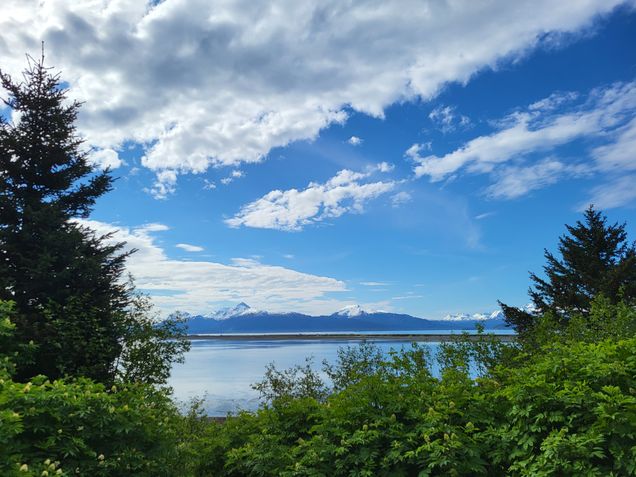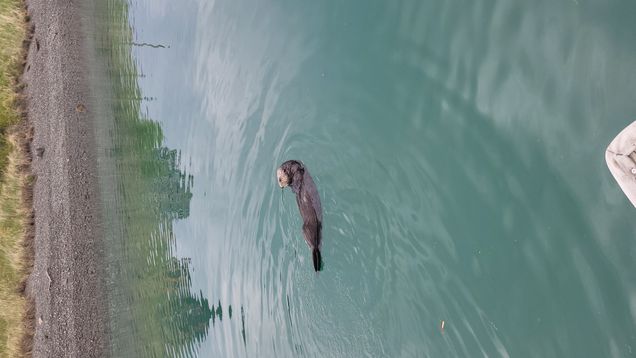Harbor Sounds and Fish Populations
Helena Shenk (CAS’26) spent her summer studying the Alaskan coastline
Helena Shenk (CAS’26) spent her summer studying the Alaskan coastline
Four hours south of Anchorage, in one of Alaska’s most popular tourist destinations, Helena Shenk spent her summer trading the classroom for the coastline.
The rising senior, a marine science major, landed an internship at the Kachemak Bay National Estuarine Research Reserve in Homer, Alas., a partnership between the University of Alaska and the National Oceanic and Atmospheric Administration (NOAA).
As a 2025 NOAA Hollings Scholar, Shenk (CAS’26) set out to gain networking and field experience in marine sciences, with the goal of eventually working at NOAA or another agency specializing in conservation. For this summer internship, Shenk had flexibility in crafting her focus, as long as it connected to nearshore fish ecology.

To figure out next steps, she quite literally listened for her calling.
Shenk used a hydrophone—an underwater microphone—to record vessel noise near a harbor being considered for expansion. She wanted to understand whether increased boat traffic could disrupt local fish species that rely on sound to communicate, attract mates, and detect predators.
At first, she had tried minnow traps (small mechanisms used to catch minnows and other small fish for scientific study) for a real-time comparison of hydrophone data paired with new collections of fish. When this didn’t work, “possibly because of small fish size and lack of prey drive,” Shenk says, she moved onto a GoPro camera to analyze videos of fish populations, but the turbidity and water currents made it difficult to capture underwater activity.
She ultimately decided to pair her hydrophone data with fish-hearing data extracted from scientific literature. She used the hydrophone to observe noise levels coming from boats entering and exiting the harbor and compared this ambient and vessel-induced noise against species-specific frequencies.
“The size of the boat did not seem to matter as much, while the actual number of vessels, no matter the size, seemed to have a very heavy correlation with the noise levels in the harbor,” says Shenk. “If the harbor expansion goes through and adds over 300 new vessels, this could tip the scale.” Exactly how detrimental the expansion could be is unclear, but she says the increased noise levels could very well impede fish communication to the extent of lower catch rates and increased larval mortality.
She wants her research to help prevent harm from happening. “This work could actually inform the next phase of development,” says Shenk. She hopes it inspires the construction of stations that assess the impact of sound on underwater habitats year round. In her perfect world, the overarching US Army Corps of Engineers will consider sound as a potential impact on local fish, as it isn’t currently factored into environmental impact surveys.

The experience was a welcome challenge for Shenk—as much a leadership opportunity as it was a hands-on master class. “There wasn’t much precedent,” Shenk says. So with the help of her mentor, who borrowed the hydrophone from a local professor, and other staff, she was able to tailor a sound-focused project that still met the requirements of the internship and fit into the scope of the timely harbor expansion. “I really had to buckle down and figure things out, but the staff was so helpful. They gave me the space to try and the support to keep going.”
Immediately after completing her internship at the end of July, she flew to Washington, D.C., and presented her findings to peers and NOAA staff.
Shenk credits a BU course called Marine Megafaunal Ecology, where she studied acoustic backscatter data and fish communication, for inspiring her project. That sparked an interest in how animals interact with their environments. “It made me realize the ocean isn’t silent,” she says. “Sound is a huge part of how marine life operates.”

While out on the Homer coastline, she also made time for other field experiences, including conducting plankton samplings and beach seines—pulling large nets through the water to collect fish for population assessments. “It’s hard work,” says Shenk. “Pulling the net onto the beach, collecting fish, identifying species, measuring them—it gives you a real connection to the ecosystem.”

She even went tide pooling in one of the highest tidal range zones in the world, discovering spiny sculpins and watching marine mammals, like porpoises, harbor seals, and sea otters. On one particularly exciting day, she spotted a Pacific white-sided dolphin—the first sighting in that area in over a decade.
Another day, she was met with a tsunami warning.
“We were in the middle of analyzing audio samples when our phones started blowing up,” Shenk recalls. Her mentor, Lauren Sutton, lived at a higher elevation and invited several staff members to wait out the warning at her home.
For Shenk, the moment was strangely affirming. “I got lucky with my placement—it’s a special community,” she says. “It also really showed me what it’s like to do science in unpredictable conditions. Even with all the mess, it was nice to feel grounded. You learn to make the best of not-ideal situations. That’s part of being a scientist.”
As thrilling as the Alaska internship was, it isn’t Shenk’s first rodeo. During the summer seasons (including this summer, prior to leaving for Alaska), she works as a fishway guide and data collector at the Robert E. Barrett Fishway in Holyoke, Mass. She grew up in nearby South Hadley, which she says is a very green place with a ton of hidden ecology. She was also raised by a botanist-taxidermist father and an artist-attorney mother. “I was destined to be obsessed with nature,” she says, with a laugh.
Looking ahead, Shenk plans to spend a semester in Dublin, Ireland, through a BU internship. She’s open to where it might lead—another marine science role or a placement focused on international relations. Her past experience could help with this: She once lived in Germany serving as a student ambassador, where she explored diplomacy and public policy.
“There’s so much interconnectivity between policy and environmentalism, and you really have to be able to know both worlds,” says Shenk. “I want to keep exploring that.”